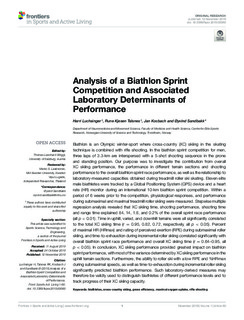| dc.description.abstract | Biathlon is an Olympic winter-sport where cross-country (XC) skiing in the skating technique is combined with rifle shooting. In the biathlon sprint competition for men, three laps of 3.3-km are interspersed with a 5-shot shooting sequence in the prone and standing position. Our purpose was to investigate the contribution from overall XC skiing performance, the performance in different terrain sections and shooting performance to the overall biathlon sprint race performance, as well as the relationship to laboratory-measured capacities obtained during treadmill roller ski skating. Eleven elite male biathletes were tracked by a Global Positioning System (GPS) device and a heart rate (HR) monitor during an international 10-km biathlon sprint competition. Within a period of 6 weeks prior to the competition, physiological responses, and performance during submaximal and maximal treadmill roller skiing were measured. Stepwise multiple regression analysis revealed that XC skiing time, shooting performance, shooting time and range time explained 84, 14, 1.8, and 0.2% of the overall sprint race performance (all p < 0.01). Time in uphill, varied, and downhill terrains were all significantly correlated to the total XC skiing time (r = 0.95, 0.82, 0.72, respectively, all p < 0.05). Percent of maximal HR (HRmax) and rating of perceived exertion (RPE) during submaximal roller skiing, and time-to-exhaustion during incremental roller skiing correlated significantly with overall biathlon sprint race performance and overall XC skiing time (r = 0.64–0.95, all p < 0.05). In conclusion, XC skiing performance provided greatest impact on biathlon sprint performance, with most of the variance determined by XC skiing performance in the uphill terrain sections. Furthermore, the ability to roller ski with a low RPE and %HRmax during submaximal speeds, as well as time-to-exhaustion during incremental roller skiing significantly predicted biathlon performance. Such laboratory-derived measures may therefore be validly used to distinguish biathletes of different performance levels and to track progress of their XC skiing capacity. | nb_NO |

